Papule vs. Nodule — What's the Difference?
By Urooj Arif & Fiza Rafique — Updated on March 27, 2024
Papules are small, raised bumps on the skin less than 1 cm in diameter, while nodules are larger, solid lesions that are deeper and over 1 cm.

Difference Between Papule and Nodule
Table of Contents
ADVERTISEMENT
Key Differences
Papules represent a type of skin lesion that appears as small, elevated bumps on the skin's surface. These lesions are typically less than 1 cm in diameter and can result from a variety of conditions, including acne, eczema, and dermatitis. On the other hand, nodules are larger and deeper lesions, often feeling solid when touched, and exceed 1 cm in diameter. They can be caused by conditions such as cysts, warts, and certain types of skin cancer.
While papules are primarily confined to the epidermal layer of the skin, making them relatively superficial, nodules extend into the dermal or even subcutaneous layers, indicating a more significant alteration in skin structure. This depth can influence the treatment approach, as nodules may require more invasive procedures compared to the topical treatments often effective for papules.
Papules are generally characterized by their color, which can vary from red to brown, depending on the underlying cause, and they often present without any visible fluid. Nodules, however, may not have a distinct color change but are notable for their size and the depth at which they are situated in the skin.
The presence of papules can indicate a wide range of skin conditions, many of which are benign or easily treatable. Nodules, due to their size and depth, may suggest a more serious underlying health issue that could require comprehensive medical evaluation and treatment.
In terms of treatment, papules often respond well to topical medications and treatments aimed at reducing inflammation and treating the underlying cause. Nodules, given their size and the potential for deeper skin involvement, might necessitate systemic treatment, such as oral medications, or in some cases, surgical intervention.
ADVERTISEMENT
Comparison Chart
Size
Less than 1 cm in diameter
Over 1 cm in diameter
Depth
Confined to the epidermal layer
Extend into the dermal or subcutaneous layers
Causes
Acne, eczema, dermatitis, infections
Cysts, warts, skin cancer, infections
Color
Can vary (red, brown); often matches skin tone
May not have distinct color change
Texture
Solid, elevated
Larger, deeper, and solid
Treatment Approach
Topical medications, lifestyle changes
Systemic treatments, surgical intervention
Indication
Often benign, treatable conditions
May indicate more serious health issues
Visibility
Visible on the skin's surface
May be visible or palpable deeper in the skin
Compare with Definitions
Papule
Small, raised bumps on the skin without visible fluid.
The dermatologist noted several papules indicative of acne.
Nodule
Larger, solid lesions that extend into the dermal or subcutaneous layer.
The nodule on her shoulder was palpable and required further investigation.
Papule
Typically less than 1 cm in diameter.
He treated the small papules on his forearm with a topical cream.
Nodule
Over 1 cm in diameter, often feeling deep and solid.
The doctor measured the nodule to be 1.5 cm in diameter.
Papule
Confined to the epidermal layer of the skin.
The biopsy showed the papules were superficial lesions.
Nodule
Can be caused by cysts, warts, or skin cancer.
The biopsy of the nodule revealed it was a benign cyst.
Papule
Often treated with topical medications.
She applied the prescribed medication directly to the papules twice daily.
Nodule
Treatment might include systemic medications or surgery.
Given its size, the nodule was removed surgically.
Papule
Can appear red or brown, depending on the cause.
The papules from her eczema were particularly itchy and red.
Nodule
May not change the color of the skin.
The nodule was the same color as his skin but was noticeable due to its size.
Papule
A papule is a circumscribed, solid elevation of skin with no visible fluid, varying in area from a pinhead to 1 cm. Papules can be brown, purple, pink or red in color, and can cluster into a papular rash.
Nodule
A small knotlike protuberance.
Papule
A small pimple or swelling on the skin, often forming part of a rash.
Nodule
(Medicine) A small, abnormal but usually benign mass of tissue, as on the thyroid gland, in the lung, or under the skin.
Papule
A small, solid, usually inflammatory elevation of the skin that does not contain pus.
Nodule
(Botany) A small knoblike outgrowth, especially one on the roots of a leguminous plant that contains bacteria that fix nitrogen.
Papule
A small, inflammatory, irritated spot on the skin, similar in appearance to a pimple, but not containing pus.
Nodule
(Mineralogy) A small rounded lump of a mineral or mixture of minerals, usually harder than the surrounding rock or sediment.
Papule
Same as Papula.
Nodule
A rounded mass or irregular shape; a little knot or lump.
Papule
A small inflamed elevation of skin that is nonsuppurative (as in chicken pox)
Nodule
A rounded mass or irregular shape; a little knot or lump.
Nodule
A small node
Nodule
Small rounded wartlike protuberance on a plant
Nodule
(mineralogy) a small rounded lump of mineral substance (usually harder than the surrounding rock or sediment)
Common Curiosities
What is a papule?
A papule is a small, raised, solid bump on the skin that is less than 1 cm in diameter, often associated with various skin conditions.
Can papules develop into nodules?
While papules and nodules are distinct types of skin lesions, some conditions may progress in a way that papules become larger and evolve into nodules.
What causes papules on the skin?
Papules can be caused by acne, eczema, dermatitis, allergic reactions, and infections.
Are nodules dangerous?
Nodules can be benign or indicative of a more serious condition such as cancer, requiring medical evaluation for an accurate diagnosis.
How are papules treated?
Treatment for papules typically involves topical creams or ointments aimed at reducing inflammation and treating the underlying cause.
Is a nodule the same as a cyst?
Not exactly; while a cyst can present as a nodule, nodules are a broader category that includes solid lesions of various causes, not just fluid-filled sacs.
Can papules and nodules occur anywhere on the body?
Yes, both papules and nodules can occur anywhere on the body, depending on the underlying cause.
Are there preventative measures for papules and nodules?
Preventative measures depend on the underlying cause but may include proper skincare, avoiding known irritants, and managing health conditions.
Can lifestyle changes impact the development of papules and nodules?
Yes, lifestyle changes like diet, stress management, and skincare routines can influence the development and severity of skin conditions leading to papules and nodules.
How are nodules different from papules?
Nodules are larger and deeper than papules, often over 1 cm in diameter, and can extend into the deeper layers of the skin.
What treatment options are available for nodules?
Treatment options for nodules may include systemic medications to address underlying issues or surgical removal, especially if there is a concern for malignancy.
What is the significance of a nodule's depth in the skin?
The depth of a nodule can indicate its potential cause and influence the choice of treatment, with deeper nodules possibly requiring more invasive interventions.
Do papules and nodules always require medical treatment?
While some papules and nodules may resolve without treatment, it is important to seek medical advice for an accurate diagnosis and appropriate treatment plan.
How do doctors diagnose the cause of papules and nodules?
Diagnosis may involve physical examination, patient history, and sometimes biopsy or other diagnostic tests to determine the underlying cause.
Share Your Discovery

Previous Comparison
Bond vs. Recall
Next Comparison
Academic vs. ScholasticAuthor Spotlight
Written by
Urooj ArifUrooj is a skilled content writer at Ask Difference, known for her exceptional ability to simplify complex topics into engaging and informative content. With a passion for research and a flair for clear, concise writing, she consistently delivers articles that resonate with our diverse audience.
Co-written by
Fiza RafiqueFiza Rafique is a skilled content writer at AskDifference.com, where she meticulously refines and enhances written pieces. Drawing from her vast editorial expertise, Fiza ensures clarity, accuracy, and precision in every article. Passionate about language, she continually seeks to elevate the quality of content for readers worldwide.















































